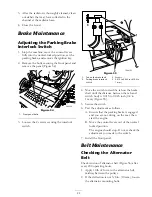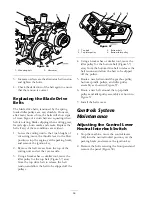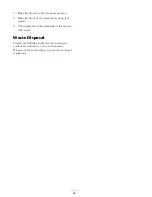
Figure 71
1. Cutting Edge
3. Wear/slot Forming
2. Curved Area
4. Crack
If you allow the blade to wear, a slot will
form between the sail and flat part of the
blade. Eventually a piece of the blade
may break off and be thrown from under
the housing, possibly resulting in serious
injury to you or bystanders.
•
Inspect the blade periodically for
wear or damage.
•
Never try to straighten a blade that
is bent or weld a broken or cracked
blade.
•
Replace a worn or damaged blade.
Checking for Bent Blades
1. Disengage the PTO, move the motion control
levers to the neutral locked position and set
the parking brake.
2. Move the throttle lever to the Slow position,
stop the engine, remove the key, and wait for
all moving parts to stop before leaving the
operating position.
3. Rotate the blades until the ends face forward
and backward (Figure 72). Measure from a
level surface to the cutting edge, position
A
, of
the blades (Figure 72). Note this dimension.
Figure 72
1. Measure here from blade
to hard surface
2. Position A
4. Rotate the opposite ends of the blades forward.
5. Measure from a level surface to the cutting
edge of the blades at the same position as
in step 3 above. The difference between the
dimensions obtained in steps 3 and 4 must not
exceed 1/8 inch (3 mm). If this dimension
exceeds 1/8 inch (3 mm), the blade is bent
and must be replaced; refer to Removing the
Blades and Installing the Blades.
64
Summary of Contents for Groundsmaster 7200 Series
Page 9: ...Slope Chart 9 ...
Page 44: ...Figure 39 44 ...
Page 70: ...Schematics Electrical Schematic Rev A 70 ...
Page 71: ...Hydraulic Schematic Rev A 71 ...























